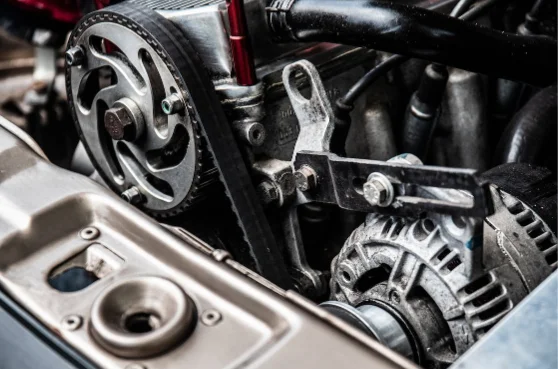It’s a moment of panic for many drivers, signaling potential trouble under the hood. But what does it really mean, and what should you do next? In this comprehensive guide, we’ll delve into the reasons behind the check engine light, why ignoring it can be a costly mistake, and the most common causes and solutions to help you navigate this automotive warning sign with confidence.
What to do when your check engine light comes on
The appearance of the check engine light can be unsettling, but it’s essential not to panic. Here’s what you should do when you notice that illuminated icon on your dashboard:
- Don’t Ignore It: Ignoring the check engine light can lead to more severe issues down the road. It’s your car’s way of alerting you to potential problems that need attention.
- Check for Immediate Issues: If you notice any other unusual symptoms such as strange noises, rough idling, or loss of power, pull over safely and assess the situation.
- Check Gas Cap: Sometimes, a loose or faulty gas cap can trigger the check engine light. Ensure the gas cap is tight and secure.
- Assess the Severity: Is the light blinking or steady? A blinking check engine light typically indicates a more serious problem that requires immediate attention. In such cases, it’s advisable to reduce speed and seek assistance promptly.
- Consult your Owner’s Manual: Your owner’s manual can provide valuable insights into what the check engine light might be indicating and any immediate actions you should take.
Why you shouldn’t ignore your check engine light
Ignoring the check engine light may seem tempting, especially if your car appears to be running smoothly. However, doing so can have serious consequences:
- Increased Repair Costs: What may start as a minor issue can escalate into a major repair if left unaddressed, resulting in higher repair bills down the line.
- Reduced Fuel Efficiency: A malfunctioning component can lead to decreased fuel efficiency, costing you more money at the pump.
- Risk of Breakdown: Ignoring the check engine light increases the risk of a sudden breakdown, potentially leaving you stranded on the side of the road.
- Environmental Impact: Some issues indicated by the check engine light can result in increased emissions, contributing to environmental pollution.
What are the implications of ignoring your check engine light?
The check engine light serves as an early warning system for potential issues with your vehicle. By ignoring it, you’re essentially disregarding crucial information about your car’s health. Here are some potential implications of ignoring the check engine light:
- Undetected Safety Hazards: Some issues indicated by the check engine light, such as faulty brakes or engine misfires, can compromise your safety on the road.
- Compromised Performance: Ignoring the check engine light can lead to decreased performance and drivability issues, making your driving experience less enjoyable.
- Long-term Damage: What may seem like a minor issue initially can cause significant damage to other components if left unresolved, leading to more extensive and costly repairs.
- Failed Emissions Test: In regions where emissions testing is mandatory, an illuminated check engine light can result in a failed inspection, leading to fines or restrictions on vehicle usage.
Most Common Causes for the Check Engine Light
The check engine light can be triggered by a wide range of issues, ranging from minor to severe. Here are some of the most common causes:
- Loose Fuel Cap: A loose or damaged fuel cap is one of the most frequent triggers for the check engine light. The fuel cap helps maintain the proper pressure in the fuel system, and if it’s loose or missing, it can allow fuel vapors to escape, triggering the light.
- Oxygen Sensor: The oxygen sensor measures the amount of oxygen in the exhaust gases and helps regulate fuel delivery to the engine. A faulty oxygen sensor can lead to improper fuel-air mixture, reduced fuel efficiency, and increased emissions.
- Other Emissions Problems:Issues with other emissions-related components, such as the catalytic converter or evaporative emission control system, can also trigger the check engine light. These problems can impact vehicle performance and emissions levels.
- Spark Plugs or Ignition Coils: Worn or faulty spark plugs or ignition coils can cause misfires, rough idling, and poor fuel economy, all of which can trigger the check engine light. Regular maintenance of these components is essential for optimal engine performance.
- Wiring Issues: Faulty wiring or electrical connections can disrupt sensor readings and lead to false triggers of the check engine light. Inspecting and repairing damaged wiring can help resolve this issue.
- Transmission: Problems with the transmission, such as low fluid levels or worn components, can trigger the check engine light. Addressing transmission issues promptly is crucial to prevent further damage to the drivetrain.
- Cooling System: Issues with the cooling system, such as a malfunctioning thermostat or coolant leak, can cause the engine to overheat and trigger the check engine light. Regular maintenance of the cooling system can help prevent these problems.
- Fuel System: Issues with the fuel system, such as a clogged fuel filter or malfunctioning fuel injectors, can disrupt fuel delivery to the engine and trigger the check engine light. Regularly servicing the fuel system can help prevent these issues.
- Engine Oil: Low oil level or dirty oil can lead to engine damage and trigger the check engine light. Regular oil changes and maintenance are essential for engine health.
FAQs
Can I continue driving with the check engine light on?
While it may be tempting to ignore the check engine light, it’s not advisable. Continuing to drive with the light on can lead to more severe issues and potential breakdowns. It’s best to have your vehicle inspected as soon as possible to determine the cause of the light.
How much does it cost to diagnose and repair the check engine light?
The cost of diagnosing and repairing the check engine light can vary depending on the underlying issue. In some cases, it may be a simple fix, while in others, it may require more extensive repairs. It’s best to consult with a qualified mechanic for an accurate diagnosis and cost estimate.
Can I reset the check engine light myself?
While it’s possible to reset the check engine light using an OBD-II scanner or by disconnecting the battery, this will only temporarily clear the code. If the underlying issue is not addressed, the light will likely reappear. It’s essential to address the root cause of the problem to prevent further issues.
How often should I check my engine light?
It’s a good idea to periodically check your dashboard for any warning lights, including the check engine light. If the light does come on, don’t ignore it – have your vehicle inspected as soon as possible to prevent potential issues.
Conclusion
The check engine light is not something to be ignored or taken lightly. It serves as a crucial indicator of potential issues with your vehicle that require attention. By understanding the causes behind the check engine light, knowing what actions to take when it illuminates,
Get the right coverage for your car with tutenagency
New tutenagency customers?
Quote auto insurance online or call (334) 502-5111 to insure your vehicle.
Disclaimer: This content is for informational purposes only and should not be considered legal or financial advice. Always consult with qualified professionals in legal and financial fields before making any decisions.

